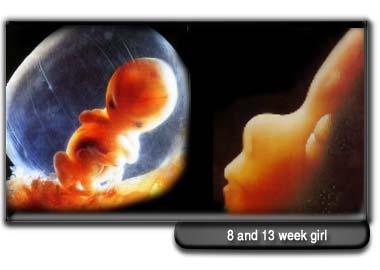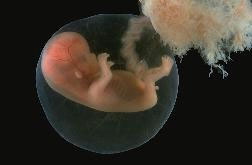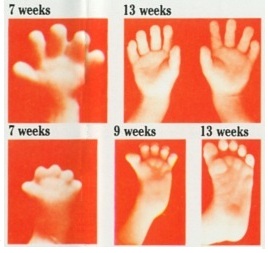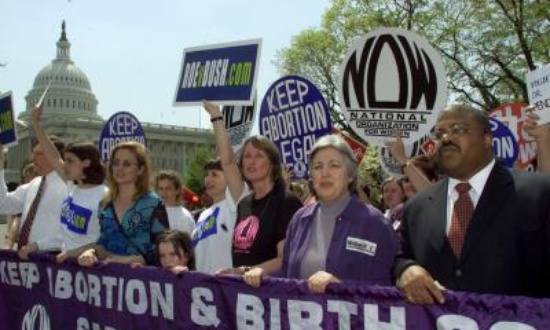 These are quotes by former clinic workers. These people have left the abortion business for various reasons. Many have left because they decided that abortion is wrong, and some are now part of the prolife movement. Most of these quotes are from private interviews by prolife organizations.
These are quotes by former clinic workers. These people have left the abortion business for various reasons. Many have left because they decided that abortion is wrong, and some are now part of the prolife movement. Most of these quotes are from private interviews by prolife organizations.
“I can remember...the resident doctor sitting down, putting the tube in, and removing the contents. I saw the bloody material coming down the plastic tube, and it went into a big jar. My job afterwards was to go and undo the jar, and to see what was inside. I didn’t have any views on abortion; I was in a training program, and this was a brand new experience. I was going to get to see a new procedure and learn. I opened the jar and took the little piece of stockingnette stocking and opened the little bag. The resident doctor said “Now put it on the blue towel and check it out. We want to see if we got it all.’ I thought, “that’ll be exciting—hands on experience looking at tissue.’ I opened the sock up and put it on the towel, and there were parts of a person in there. I had taken anatomy, I was a medical student. I knew what I was looking at. There was a little scapula and an arm, I saw some ribs and a chest, and a little tiny head. I saw a piece of a leg, and a tiny hand and an arm, and you know, it was like somebody put a hot poker into me. I had a conscience, and it hurt. Well, I checked it out and there were two arms and two legs and one head and so forth, and I turned and said “I guess you got it all.’ That was a very hard experience to go through emotionally.” (Dr. Brewer describes that, as time went on, seeing abortions became less and less painful. He hardened his heart and went on to perform them. In his career, he performed thousands.) - Dr. David Brewer
“You would just look in the buckets and see arms and legs. I have horrible dreams about that now. It was something you would see in a scary movie.” - Kirsten Breedlove, Former Clinic Worker
“Another thing that bothered me as I went about my work at the clinic was the fact that I had seen an ultrasound abortion. We did first trimester abortions. This was a late first trimester, probably second trimester. I handled the ultrasound while the doctor performed the procedure and I directed him while I was watching the screen. I saw the baby pull away.... I had seen the Silent Scream a number of times, but it didn’t effect me. To me it was just more prolife propaganda. But I couldn’t deny what I saw on the screen.” - Joan Appleton, Former Clinic Worker
“I walked in the laboratory every day. I saw dead babies every day for three years. If I could see fifty, I was so happy. Because, you know what? That meant I was really gonna’ have a good bonus in my paycheck.” - Hellen Pendley, Clinic Worker
“I was for abortion, I thought it was a woman’s right to terminate pregnancy she did not want. Now I’m not so sure. I am a student nurse nearing the end of my OB-GYN rotation at a major metropolitan hospital and teaching center. It wasn’t until I saw what abortion really involves that I changed my mind. After the first week in the abortion clinic several people in my clinical group were shaky about their previously positive feelings about abortion. This new attitude resulted from our actually seeing a Prostaglandin abortion, one similar in nature to the widely used saline abortion….this method is being used for terminations of pregnancies of sixteen weeks and over. I used to find rationales. the fetus isn’t real. Abdomens aren’t really very swollen. It isn’t ‘alive.’ No more excuses...I am a member of the health profession and members of my class are now ambivalent about abortion. I now know a great deal more about what is involved in the issue. Women should perceive fully what abortion is; how destructive an act it is both for themselves and their unborn child. Whatever psychological coping mechanisms are employed during the process, the sight of a fetus in a hospital bedpan remains the final statement.” - Abortion Nurse
“I got to where I couldn’t stand to look at the little bodies anymore.” - Dr. Beverly McMillan, when asked why she stopped performing abortions
“I have been there, and I have seen these totally formed babies as early as ten weeks...with the leg missing, or with their head off. I have seen the little rib cages...” - Deborah Henry, Former Clinic Worker
“When a later abortion was performed, workers had to piece the baby back together, and every major part—head, torso, two legs, and two arms—had to be accounted for. One of our little jokes at the clinic was, “If you ever want to humble a doctor, hide a leg so he thinks he has to go back in.” Please understand, these were not abnormal, uncaring women working with me at the clinic. We were just involved in a bloody, dehumanizing business, all of us for our own reasons. Whether we were justifying our past advocacy (as I was), justifying a previous abortion (as many were) or whatever, we were just trying to cope—and if we couldn’t laugh at what was going on, I think our minds would have snapped. It’s not an easy thing trying to confuse a conscience that will not stay dead.” - Norma McCorvey
“I’ve never been able to come up with the words to describe the abortion procedure..... no matter how bad you think abortion is, there are no words to describe how bad it really is. It kills the baby. And, yes, I’ve seen sonograms with the baby pulling away from the instruments that are introduced into the vagina. And the woman, the mother is hurt if she doesn’t have the money to be put to sleep... ”I’ve seen babies aborted—we had one that was so big it wouldn’t go down the disposal. We had one that was so big that it came out in two pieces. The head and a body. I sat down with a doctor not long ago and he told me that it was probably almost a term baby, simply because of what I could remember about it and specifics. ”After the abortion, the girls are brought into the recovery room where there are two reactions. The first is: ‘I killed my baby.’ It amazed me that it was it is the first time they called it a baby and the first time they called it murder. That is probably the healthiest reaction. That woman is probably going to have the ability to walk out of there and deal with it, and perhaps be healed and move on. ”The second reaction is ‘I am hungry. You kept me in here for four hours and you told me I’d only be in for two. Let me out of here.’ She is running from her abortion. She is not dealing with it. She is choosing to deny it. They say its now an average of five years before people actually deal with the fact that, yes, they did kill their baby.” - Carol Everett, Former Abortion Clinic Director (4 clinics)
“The vacuum machine is used [for first trimester abortions] and the vacuum tubing empties into a tiny little cheesecloth sack. That little cheesecloth sack is about this big and in it are the products of conception. That’s what we called it. We sent those down to pathology. In my second year of residency, I spent two months on a pathology rotation, which is an interesting thing, and I had to come face to face with the contents of those sacks. We were studying embryology of the ovary...I, personally, then had to search through the jumbled-up mass of tissue to find the fetal gonads, to be sure to include them on the slide so that we could study them. The jumbled-up mass of tissue was easily identifiable as the torn and shredded body of a tiny human being....half of the aborted fetuses were males...Even though these discoveries made me uncomfortable, I continued to do abortions. There were times when I personally sat there and opened up containers, five, six, seven containers at a time, and would open them up and stand and look at the [contents.]” - Dr. McArthur Hill, Former Abortion Provider
 “I worked in the clean-up room, in my opinion the worst part of the clinic because it was so messy. You had to wear rubber gloves...That’s where the babies were brought back. At the time I worked there, they only did first trimester abortions; they didn’t have the facilities to do second trimester abortions. But, oftentimes, second trimester abortions were performed and these babies we would not put in the little jar with the label to send off to the pathology lab. We would put them down a flushing toilet. They had a toilet that was mounted to the wall, and it was a continually flushing toilet; it didn’t have a lid or a handle. That’s where we would put those babies. They knew they couldn’t turn them in or they were going to be found out that they were doing abortions which were too late term...The ones that were small enough, which would be 12-13 weeks or less, we would put in a jar, label them, and put them in a big box to go off to the pathology lab...When the babies would be put in the jars, we would hold them up and kind of twirl them around and look at the little arm and little leg float up and we’d put them back in the box. As sick as that sounds, that’s the way it was, and that’s the way it is at a lot of places right now.”
”One of the first abortions done that day was on a woman who was 23 weeks pregnant. This woman should have had a saline or laminaria abortion, or even a hysterotomy. Anything would have been better than to try to do a D&C on a woman who was that far along. You have to realize that in this particular abortion clinic, what would be done was that she would be examined one side; a pelvic exam by one doctor; then she’d come over and go through all the blood work and sign a release paper, etc. Then, by the time it was time for her abortion, she would be examined a second time. So we’re talking about two different doctors doing a pelvic exam who knew this lady was farther than 12 weeks along....This woman was in so much pain, she was coming off the table. Every medical assistant and nurse was in that room...She was screaming, the nurse was yelling at her because everybody else was getting quite upset in the waiting area, as you can imagine, from this woman who was screaming. The doctor was trying to do the abortion, and the baby’s bones were far too developed to rip them up with this curette, and so he had to try and pull the baby out with forceps, which he brought out in three or four major pieces. Then he scraped and suctioned and scraped and suctioned. There this little baby boy was laying on the tray. I took the baby and I took him to the clean-up room, and I set him down...His little face was perfectly formed....everything was perfect about this little boy.” - Kathy Sparks, Former Clinic Worker
“I worked in the clean-up room, in my opinion the worst part of the clinic because it was so messy. You had to wear rubber gloves...That’s where the babies were brought back. At the time I worked there, they only did first trimester abortions; they didn’t have the facilities to do second trimester abortions. But, oftentimes, second trimester abortions were performed and these babies we would not put in the little jar with the label to send off to the pathology lab. We would put them down a flushing toilet. They had a toilet that was mounted to the wall, and it was a continually flushing toilet; it didn’t have a lid or a handle. That’s where we would put those babies. They knew they couldn’t turn them in or they were going to be found out that they were doing abortions which were too late term...The ones that were small enough, which would be 12-13 weeks or less, we would put in a jar, label them, and put them in a big box to go off to the pathology lab...When the babies would be put in the jars, we would hold them up and kind of twirl them around and look at the little arm and little leg float up and we’d put them back in the box. As sick as that sounds, that’s the way it was, and that’s the way it is at a lot of places right now.”
”One of the first abortions done that day was on a woman who was 23 weeks pregnant. This woman should have had a saline or laminaria abortion, or even a hysterotomy. Anything would have been better than to try to do a D&C on a woman who was that far along. You have to realize that in this particular abortion clinic, what would be done was that she would be examined one side; a pelvic exam by one doctor; then she’d come over and go through all the blood work and sign a release paper, etc. Then, by the time it was time for her abortion, she would be examined a second time. So we’re talking about two different doctors doing a pelvic exam who knew this lady was farther than 12 weeks along....This woman was in so much pain, she was coming off the table. Every medical assistant and nurse was in that room...She was screaming, the nurse was yelling at her because everybody else was getting quite upset in the waiting area, as you can imagine, from this woman who was screaming. The doctor was trying to do the abortion, and the baby’s bones were far too developed to rip them up with this curette, and so he had to try and pull the baby out with forceps, which he brought out in three or four major pieces. Then he scraped and suctioned and scraped and suctioned. There this little baby boy was laying on the tray. I took the baby and I took him to the clean-up room, and I set him down...His little face was perfectly formed....everything was perfect about this little boy.” - Kathy Sparks, Former Clinic Worker
“One of the girls called me into the lab as she was cleaning up, and on the end of the cannula, which was the instrument at the end of the hose, was a little baby’s foot. It was about half an inch long. This foot was perfectly formed. I couldn’t believe it. I was so amazed at the sight of it. It was all black and blue...The baby’s body was completely ripped apart because of the abortion. ”I know that the Lord has forgiven me, but I can never erase those things from my mind. The sounds of those bones breaking. The sight of those babies...You tell me that this baby doesn’t feel anything. I will tell you differently.” - Deborah Henry, Former Clinic Worker
“I wanted to be the world’s best abortionist, for the good of my patients. If I was going to do this, I was going to do it right. So, after I met each patient, reviewed the medical information gathered by my nurse, examined the patient and performed the abortion, I would then carefully sift through the remains to be sure all the parts were accounted for. I had to find four extremities (two arms and two legs) a spine, a skull, and the placenta, or my patient would suffer later from an incomplete abortion...My attention was so focused on my perceived patient that I managed to deny that there were, in fact, two patients involved—the expectant mother and a very small child...I had to wonder, how can having a child be so wrong for some people that they will pay me to end its life?” - Dr. Beverly McMillan, Former Abortionist
“I am deeply troubled by my own increasing certainty that I have in fact presided over 60,000 deaths. There is no longer serious doubt in my mind that human life exists from the very onset of pregnancy.” - Dr. Bernard Nathanson
“Each person who worked there had a different way of dealing with it. [One] would look at the ultrasound the entire time she was in the room, but she would never look down in the pan. She would never look at the tissue being removed. She never wanted to see that. She would never take her eyes off the screen. And I had one who would never look at the screen....she would never look at the tissue and never look at the screen, she just didn’t want to see anything.” - Former clinic worker
“Planned Parenthood is set up so clinic workers never have to see the babies. It’s set up that way because having to look at the babies bothers the workers....Generally there is one clinic worker in charge of the babies...I was that clinic worker. I had to look at the babies. I had to store them, I had to send them to pathology. And I was the person who had to dispose of them...in order to maintain my sanity, I established a personal mourning ritual....I said prayers for the dead. I also named the babies as I put them in a waste container.” - Former clinic worker
“My official title at the mill was ‘health worker.’I did various duties—lab work, leading groups (deceiving women about their abortions), ‘advocating’ (deceiving women during their abortions), and assisting the abortionist, which included helping during the abortion and checking to make sure all the parts of the baby were there in the collection jar afterwards. I will never forget, in the second-trimester abortions, holding those little feet up to a chart on the wall to make sure of the age of the baby.” - Dina Madsen
“My 23rd abortion changed my mind about doing abortions forever. This patient was a little overweight and ultimately proved to be a little farther along than anticipated. This was not an uncommon mistake before ultrasound was readily available to confirm the gestational age. Initially, the abortion proceeded normally. The water broke, but then nothing more would come out. When I withdrew the curette, I saw that it was plugged up with the leg of the baby which had been torn off. I then changed techniques and used ring forceps to dismember the 13 or 14 week size baby. Inside the remains of the rib cage I found a tiny, beating heart. I was finally able to remove the head and looked squarely into the face of a human being—a human being that I had just killed.” - Dr. Paul Jarrett
 “I saw a little foot—caught in the end of the suction tube.” - Nurse who assisted in a number of suction abortions, after viewing the aftermath of one for the first time.
“I saw a little foot—caught in the end of the suction tube.” - Nurse who assisted in a number of suction abortions, after viewing the aftermath of one for the first time.
“I started my job functioning in all the duties of a nurse. First by preparing the “clients” in the waiting room by medicating them with valium and then influencing my captive audience to write letters to the elected officials pleading that abortion should remain a women’s right. On into the procedure room where I assisted the “physician” with the gory practice of killing the unborn child while demeaning the “client.” Upon completion of the procedure, I placed a sanitary napkin on the “client” and walked her to the recovery room where she sat in a chair, was given medication and was timed to leave in approximately 40 minutes or sooner depending on the case load and the demand for the chair. As a surgical nurse I had the responsibility to prepare the room for the next “client,” then take the fetal parts to the lab to check and count them. This was called a GROSS and afterwards, I prepared them for disposal.” - Lorraine LaNeve, Former Clinic Worker
“To begin, I must say that until yesterday, Friday, July 2, 2004, I was strongly prochoice. I am a pre-medical student, and being very scientific, I understood that the mass of cells that forms the fetal body is not often capable of survival before 24 weeks in the womb. I am also somewhat liberal, and I believed that every woman should have the right to choose what she did with her body and one that could potentially be growing inside of her. This summer, I was accepted into a pre-medical program in NYC in which we are allowed to shadow doctors and see all sorts of medical procedures. When given the opportunity to see an abortion, I did not hesitate to accept the offer. It was something new, edgy, and exciting that I had never seen. When I entered the operating room, it felt like any other I had ever been in. On the table in front of me, I saw a woman, legs up as if delivering a child although she was asleep. Next to her was a tray of instruments for the abortion and a vacuum machine for suctioning the fetal tissues from the uterus. The doctors put on their gowns and masks and the procedure began. The cervix was held open with a crude metal instrument and a large transparent tube was stuck inside of the woman. Within a matter of seconds, the machine’s motor was engaged and blood, tissue, and tiny organs were pulled out of their environment into a filter. A minute later, the vacuum choked to a halt. The tube was removed, and stuck to the end was a small body and a head attached haphazardly to it, what was formed of the neck snapped. The ribs had formed with a thin skin covering them, the eyes had formed, and the inner organs had begun to function. The tiny heart of the fetus, obviously a little boy, had just stopped-forever. The vacuum filter was opened, and the tiny arms and legs that had been torn off of the fetus were accounted for. The fingers and toes had the beginnings of their nails on them. The doctors, proud of their work, reassembled the body to show me. Tears welled up in my eyes as they removed the baby boy from the table and shoved his body into a container for disposal. I have not been able to think of anything since yesterday at 10:30 besides what that baby boy might have been. I don’t think that people realize what an abortion actually is until they see it happen. I have been tortured by these images—so real and so vivid—for two days now...and I was just a spectator. Never again will I be prochoice, and never again will I support the murder of any human being, no matter their stage in life.” - Anonymous Student
“...I was challenged on numerous occasions by prolife Christians who tried to convince me that what I was doing was wrong. By then I had convinced myself that abortions were going to happen whether I did them or not and that I genuinely cared about those women what they were going through... I could do mid trimester procedures and carefully count body parts and never think about the baby that might have been. The fact that I was able to do this seems impossible to me now...It was not until I was pregnant myself that I began to really examine my feelings about the moral aspects of abortion. It had taken me over a year to become pregnant with my daughter. The first time I saw the tiny little flicker of her heartbeat on an ultrasound screen I fell completely in love with her. I finally had to come to terms with the fact that the only thing that made my daughter any different than all those tiny babies I had terminated was the fact that I wanted her. It was as if the scales fell from my eyes and I was at last able to see what I had not allowed myself to see in all those years of doing terminations...” - Dr. Yvonne Frank Sims, Former Abortionist
“Clinic workers may say they support a woman’s right to choose, but they will also say that they do not want to see tiny hands and tiny feet....there is a great difference between the intellectual support of a woman’s right to choose and the actual participation in the carnage of abortion. Because seeing body parts bothers the workers.” - Judith Fetrow, Former Clinic Worker from San Francisco
“I found much distress in the clinic, but it involved not only the women. I saw the pain of the babies who were born burned from the saline solution used for late-term abortions. I saw the bits of feet, bits of hands, the mangled heads and bodies of the little people. I saw pain and felt pain.” - Paula Sutcliffe, One Time Clinic Worker
“Tearing a developed fetus apart, limb by limb, is an act of depravity that society should not permit. We cannot afford such a devaluation of human life, nor the desensitization of medical personnel it requires. This is not based on what the fetus feels but on what we should feel in watching an exquisite, partly formed human being being dismembered.” ”I wish everybody would witness a second-trimester abortion before developing and opinion about it.” - Dr. George Flesh
“At least once a week—sometimes twice—I would be the resident whose turn it was to sit down and do the four, or five, or six suction D&C abortions that morning. When you finish a suction D&C the doctor has to open a little suction bag and he has to literally reassemble the child. You have to do that because you want to make sure he didn’t leave anything.” ”I bet the majority of obstetricians now have ultrasound machines in their office. We use that ultrasound machine on a daily basis. As a doctor, you know that there are children; you know that these are human beings with arms and legs and heads and they move around and are very, very active. But you get reminded. Because you see the children in there—hearts beating, arms flinging.” - Dr. Anthony Levantino
“I remember one afternoon in particular, a very attractive young woman who was the day-to-day manager of the clinic came up to the sink one day while I was getting ready to go through my little procedure, and she said, would you let me see? I’ve never really seen what you look at at the sink. I said, sure, and I started showing her. And this happened to be about a 12-week abortion, and that was about the farthest along we went. That day as I was showing her, I remember very clearly seeing an arm and seeing the deltoid muscle, and it just really struck me that day how beautiful that was. The thought just flashed through my mind: What are you doing? Here is this beautiful piece of human flesh here, what are you doing? That was one of the very last ones that I did.” - Dr. Beverly McMillan
The previous information was compiled by Sarah Terzo. You may view her website which is complete with documented footnotes.




